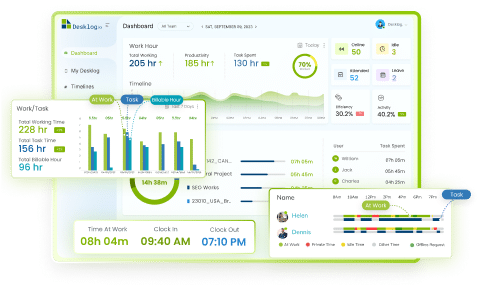Nearly every employee at some point in their professional journey, would have thought of working on an alternative schedule. Am I right?
You might have heard of 2 2 3 work schedule, 9/80 work schedule. Have you?
Well today, let me introduce a new work schedule that would provide you with extended weekends and a good work life balance – ‘The 4/10 work schedule’. This innovative concept replaces the usual five-day workweek in favor of a more streamlined approach: four 10 hour workdays followed by a glorious three-day weekend.
Read on to find out what 4/10 shift schedule is and how it works. Let’s create a happier, more productive you!
What is the 4/10 Work Schedule?
A 4/10 work schedule, also referred to as a compressed schedule, is when employees complete their full 40-hour workweek within four days instead of the usual five. This arrangement lets employees work 10 hours each day across those four days. And they will get 3 consecutive days off in the weekend. And notably, these compressed schedules aren’t confined to the typical 9-5 office environment.
So, how does it work?
In a 4/10 schedule, employees work four 10-hour days instead of the typical five 8-hour days. This allows them to compress their entire workweek into four days, granting them a three-day weekend.
For example, an employee might work Monday through Thursday, followed by 3 consecutive days off, including Fridays, Saturdays, and Sundays. The specific days off can vary depending on the company’s needs and employee preferences.
Here’s a breakdown:
Workweek: 40 hours
Daily Shifts: 10 hours
Days Worked: 4 days
Days Off: 3 days (consecutive)
4/10 Work Schedule Example
The implementation of a 4/10 work schedule can be tailored to suit the specific needs of a company and its employees. While the core structure involves working four 10-hour days, the exact start and end times may vary significantly. This adaptability allows businesses to create shifts that align with their operational requirements.
For example, some employees may prefer to work Monday through Thursday, from 7:00 AM to 5:00 PM, while others might opt for a later start, such as 10:00 AM to 8:00 PM. Additionally, some teams might allow for staggered days off; for example, an employee could work Monday through Wednesday and take Thursday off, then work Friday and Saturday, giving them a unique schedule that accommodates personal commitments and enhances work-life balance.
This flexibility not only fosters a sense of autonomy among employees but also ensures that the company maintains productivity, with all employees still contributing the same total hours in a week.
Benefits of the 4/10 Work Schedule
The concept of a four-day workweek is no longer science fiction. Companies worldwide are embracing the 4/10 work schedule, and for good reason. This compressed workweek offers a win-win situation for both employees and employers. Here are the advantages that this innovative schedule brings to the table.

Did You Know?
78% of employees reported that the 4-day workweek made them happier at work and less stressed.
Employee Advantages
- Enhanced Work-Life Balance: An extra day off translates to more time for personal pursuits, family, and mental well-being. This can lead to a happier, less stressed workforce.
- Boosted Productivity: Knowing they have a shorter workweek, employees might be more focused and efficient during their 10 hour shifts.
- Improved Recruitment and Retention: Offering a 4/10 schedule demonstrates a company’s commitment to work-life balance. Reduced absenteeism due to better well-being is another perk.
- Reduced Commuting Costs & Environmental Impact: With one less workday, employees save money and time on commuting, contributing to a smaller carbon footprint.
Employer Advantages
- Increased Employee Satisfaction: A well-rested and rejuvenated workforce leads to higher morale, loyalty, and potentially less turnover.
- Potential Cost Savings: Depending on the industry, a four-day workweek can lead to reduced overhead costs like utilities and office supplies.
- Enhanced Employer Brand: By offering a progressive work schedule, companies can attract and retain top talent in a competitive job market.
- Improved Focus and Efficiency: With a 4/10 schedule, employees might be more focused during their workdays, leading to increased productivity.
Discover how shift scheduling software helps in managing a 4/10 work schedule.
Drawbacks of the 4/10 Work Schedule
The 4/10 work schedule comes with drawbacks too. Here’s a closer look at some challenges associated with this compressed workweek.
Employee Challenges
- Extended Workdays: Ten hour shifts can be physically and mentally draining. Even the most focused employees might struggle to maintain peak productivity.
- Work-Life Balance Paradox: A four day continuous work for 10 hours can be exhausting. This could lead to employees neglect the intended work-life balance benefit.
- Not for Everyone: Certain roles, particularly those requiring client interaction or adhering to strict schedules, might not be compatible with a compressed work schedule.
Employer Challenges
- Staffing Shortages: With a portion of the workforce off on any given day, companies might face challenges in maintaining consistent staffing levels.
- Communication and Collaboration: The compressed schedule can make communication and collaboration between teams more difficult.
- Industry Compatibility: The 4/10 schedule might not be suitable for all industries. Businesses that rely on 24/7 operations could struggle to adapt.
A Step-by-Step Guide to Implement the 4/10 Work Schedule

The 4/10 work schedule has captured the attention of businesses and employees alike. But transitioning from a traditional workweek to a compressed one requires careful planning and clear communication. Here’s a detailed roadmap to guide you through the first-time implementation of the 4/10 workweek:
Step 1: Open Communication and Collaborative Planning
- Start by holding a company-wide meeting to announce the 4/10 workweek initiative. Explain the potential benefits and challenges, emphasizing the company’s commitment to making it successful.
- Ensure all managers are on board and understand the logistical implications. Involve them in planning discussions to address potential concerns and gather feedback.
- Open communication is crucial. Conduct surveys or hold focus groups to understand employee preferences for scheduling and workload distribution during the compressed workweek.
Step 2: Crafting a Comprehensive Policy
- Clearly outline the details of the 4/10 workweek. This includes the number of workdays, daily work hours, and the designated days off.
- Determine how overtime will be handled under the new schedule. Will it be discouraged due to the longer workdays, or will there be a clear policy for overtime pay?
- Establish guidelines on how to prioritize and manage workloads effectively during the compressed workweek. Consider the use of project tracking or time tracking tools for employees.
Step 3: Adapting and Improving for Success
- Roll out the 4/10 workweek and closely monitor its impact on productivity, employee well-being, and overall company operations.
- Schedule regular check-ins with employees and managers to gather feedback on their experiences with the new schedule.
- Based on the feedback, make necessary changes if needed. Adjust core working hours, offer flexible start and end times, or explore different rotation schedules for days off.
What are the Alternative Work Schedules for Modern Workplace?
As the workplace evolves, businesses are shifting from the traditional 9-to-5 to more flexible schedules. To address these challenges, alternative work schedules have emerged, offering flexible options that align with both operational demands and employee well-being. Let’s find out the most popular work schedules that are best for organizations and they are;
- Compressed Work Schedule
- Flexible work schedules
- 2-2-3 work schedule
- 9/80 work schedules
Compressed Work Schedule
A compressed work schedule lets employees work longer hours over fewer days, such as working ten hours over four days instead of eight over five. offers extended weekends or extra days off while still fulfilling a 40-hour workweek.
Flexible work schedules
Flexible work schedules/Flextime allows employees to choose their work hours, including options like remote work, staggered hours, and compressed weeks. It enhances job satisfaction and work-life balance but requires strong communication and planning to ensure collaboration.
2-2-3 Work Schedule
The 2-2-3 schedule, common in industrial sectors, involves two 12-hour shifts, two days off, then three shifts before another break. Implementing 2-2-3 work schedule ensures 24/7 coverage while offering regular breaks, boosting operational efficiency and employee morale.
9/80 work schedule
The 9/80 schedule lets employees work 80 hours in nine days, with an extra day off every other week. It balances four nine-hour shifts and an eight-hour Friday one week, followed by four nine-hour days and Friday off the next week. To successfully carry out a 9/80 schedule, organizations should consider factors such as employee preferences, workload distribution, and communication of expectations.
Tips for Working a Compressed Workweek
As workplaces evolve, the compressed workweek offers a flexible alternative to the traditional schedule, providing longer weekends. Here are tips to stay motivated and productive in this new setup:
Utilize Time Management Techniques
Effective time management is key to staying focused. Use tools like the Eisenhower Matrix to prioritize tasks and the Pomodoro Technique for focused 25-minute work sessions with breaks. Regularly reviewing priorities and taking thoughtful breaks prevents burnout and boosts productivity.
Using Technology For Accuracy
As businesses adopt compressed workweeks, technology like video conferencing, collaboration tools, time-tracking software, and cloud services enable seamless communication and productivity. These tools simplify operations, support remote work, and enhance employee satisfaction.
Plan Your Weekly Tasks
Start each week by listing your tasks to stay focused during longer workdays. Be mindful of time spent on breaks, as you’ll need to meet deadlines sooner with the extra day off.
Seek Support When Needed
If overwhelmed by a compressed schedule, seek support from your supervisor. Simplify tasks, set clear availability expectations, and schedule regular check-ins to enhance collaboration and stay aligned with your team.
Take Care of Yourself
Self-care is vital in a compressed schedule. Prioritize regular breaks, establish boundaries by disconnecting after hours, and engage in hobbies or family time to maintain a healthy work-life balance.
Stay Flexible
Flexibility is essential in a compressed workweek. Be open to adjusting your schedule and regularly assess its effectiveness, adapting based on feedback to improve collaboration and productivity for everyone involved. Incorporating these strategies into your routine can help you navigate the challenges of a compressed workweek, enhancing productivity while maintaining a healthy work-life balance.
Is The 4/10 Work Schedule Right For You?
The 4/10 work schedule isn’t a one-size-fits-all solution. For some businesses, it can lead to a happier, more productive workforce. For others, the challenges might outweigh the benefits. For individuals, the longer work days might be a dealbreaker, while others might cherish the extended weekend.
Hence, before you start picturing endless leisure time, it’s crucial to consider if this workweek aligns with your needs, whether as a business or an individual.
Here are some key factors to consider when deciding if the 4/10 work schedule is the right fit:
- Does your business operate 24/7 or rely on strict deadlines? The 4/10 schedule might be challenging to implement in such scenarios.
- Consider the roles within your company. Are there positions that require constant coverage or client interaction that wouldn’t be feasible with a 4/10 shift schedule?
- Does your team have the necessary tools and communication channels to collaborate effectively with fewer colleagues available on any given day?
- Can the employees handle the intensity of 10-hour workdays? Some individuals thrive in focused, longer shifts, while others might find them draining.
- Are you employees confident in their ability to prioritize and manage your workload effectively within this schedule?
- Do they value a clear separation between work and personal life? The 4/10 schedule can blur those lines if they are not careful.
In Conclusion
So, you might have understood that the 4/10 work schedule could be the key to unlocking a better work-life balance for you.
While longer work days take some getting used to, the potential benefits for both employees and employers are undeniable. Increased productivity, happier employees, and reduced overhead costs are just a few reasons to consider a 4/10 shift schedule.
However, before implementing the schedule, talk to your employer about the possibility of a 4/10 work schedule. They might be surprised at how much it benefits everyone on the team. After all, a well-rested and rejuvenated workforce is a recipe for success!
FAQ
1 What are flexible schedules including 4/10 options?
Employees who work a 4/10 schedule have increased flexibility with their days off. They can choose to work four consecutive 10-hour days. This flexibility allows for a better work-life balance.
2 Is 4/10 a good schedule?
According to Workforce Institute’s research, it reduces employee stress and enhances their overall happiness and well-being. But it comes with challenges too. So, we could say, it’s good for some reasons but it also poses drawbacks.
3 What are the different types of work schedules?
There are different types of work schedules in the business world. Some of them include: 2 2 3 work schedule, Dupont work schedule, 9/80 work schedule, Rotating shift schedule, Irregular shift schedule, etc.
4 What is the difference between 9/80 and 4/10 schedules?
The 4/10 schedule can be demanding with its 10 hour workdays, whereas the 9/80 option provides a more evenly distributed workload, which many may find more manageable. Furthermore, businesses operating on a 9/80 schedule stay open for five days each week, mitigating worries about potential gaps in customer or client service.
5 What is a flexible work schedule?
Flexible work hours are the temporary adjustments to an employee’s usual schedule, whether planned or unplanned, to accommodate short-notice or occational events. This flexibility enables employees to stay within a 40-hour work week limit and helps them avoid the need for paid or unpaid time off due to absences.
6 What is the 4-11 schedule?
The 4-11 schedule involves employees working an average of 42 hours per week, accomplished through 12-hour shifts. This arrangement is commonly known as the ‘4-day shift plan’.















